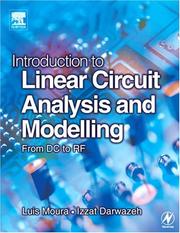| Listing 1 - 4 of 4 |
Sort by
|
Book
ISBN: 0070108986 9780070108981 Year: 1987 Publisher: New York, NY : McGraw-Hill,
Abstract | Keywords | Export | Availability | Bookmark
 Loading...
Loading...Choose an application
- Reference Manager
- EndNote
- RefWorks (Direct export to RefWorks)
Electric circuits, Linear. --- Electric circuits, Nonlinear. --- Circuits électriques linéaires --- Circuits électriques non linéaires --- Electric circuits, Nonlinear --- Electric circuits, Linear --- 621.3 --- Nonlinear electric circuits --- Linear electric circuits --- Electrical engineering --- 621.3 Electrical engineering --- Circuits électriques linéaires --- Circuits électriques non linéaires

ISBN: 1280629088 9786610629084 008045478X 0750659327 9780080454788 9780750659321 Year: 2005 Publisher: Amsterdam ; Boston : Newnes,
Abstract | Keywords | Export | Availability | Bookmark
 Loading...
Loading...Choose an application
- Reference Manager
- EndNote
- RefWorks (Direct export to RefWorks)
Luis Moura and Izzat Darwazeh introduce linear circuit modelling and analysis applied to both electrical and electronic circuits, starting with DC and progressing up to RF, considering noise analysis along the way.Avoiding the tendency of current textbooks to focus either on the basic electrical circuit analysis theory (DC and low frequency AC frequency range), on RF circuit analysis theory, or on noise analysis, the authors combine these subjects into the one volume to provide a comprehensive set of the main techniques for the analysis of electric circuits in these areas.
Electric circuit analysis. --- Electric circuits, Linear. --- Electric circuits, Linear.Electric circuit analysis.Electric circuits--Mathematical models. --- Electric circuits, Linear --- Electric circuit analysis --- Electric circuits --- Electrical & Computer Engineering --- Engineering & Applied Sciences --- Electrical Engineering --- Mathematical models --- Mathematical models. --- Circuits, Electric --- Circuit analysis, Electric --- Linear electric circuits --- Electric lines --- Electric network analysis --- Electrical engineering
Book
ISBN: 047181525X 9780471815259 Year: 1970 Publisher: London Wiley-Interscience
Abstract | Keywords | Export | Availability | Bookmark
 Loading...
Loading...Choose an application
- Reference Manager
- EndNote
- RefWorks (Direct export to RefWorks)
Electrical engineering --- Electric circuits, Linear --- Electric networks, Active --- Circuits électriques linéaires --- netwerk --- oscillator --- lineair netwerk --- 621.3.011.7 --- Active electric networks --- Networks, Active --- Electric networks --- Linear electric circuits --- Fundamental properties of active or passive networks. Network theory, analysis, synthesis. Fundamental formulae, quantities, properties --- Electric circuits, Linear. --- Electric networks, Active. --- 621.3.011.7 Fundamental properties of active or passive networks. Network theory, analysis, synthesis. Fundamental formulae, quantities, properties --- Circuits électriques linéaires
Book
ISBN: 1281791857 9786611791858 0387097406 3540097406 9783540097402 Year: 1980 Publisher: Berlin : Springer-Verlag,
Abstract | Keywords | Export | Availability | Bookmark
 Loading...
Loading...Choose an application
- Reference Manager
- EndNote
- RefWorks (Direct export to RefWorks)
Classical Circuit Theory provides readers with the fundamental, analytic properties of linear circuits that are important to the design of conventional and non-conventional circuits in modern communication systems. These properties include the relations between phase and gain, between the real and imaginary parts, and between phase and group delay. They also include the fundamental limitations on gain and bandwidth, which are important in broadband matching in amplifier design. The idea that an impedance function is a positive real function and that a transfer function is bounded-real, forms the basis for analytic design of all conventional filters. At the same time, mathematical programming tools are now widely available so that design of non-conventional circuits by optimization is but a few mouse clicks away. Every new concept within the material is illustrated with one or more examples. There are exercises and problems at the end of the chapters. Some may be suitable for term projects. The design techniques presented are also illustrated step by step with easy-to-follow examples.
Electric circuit analysis. --- Electric circuits, Linear --- Design and construction. --- Mathematics. --- Linear electric circuits --- Circuit analysis, Electric --- Electric circuits --- Electric network analysis --- Numerical analysis --- Congresses. --- Systems engineering. --- Electronics. --- Circuits and Systems. --- Electronics and Microelectronics, Instrumentation. --- Engineering systems --- System engineering --- Engineering --- Industrial engineering --- System analysis --- Electrical engineering --- Physical sciences --- Design and construction --- Electronic circuits. --- Microelectronics. --- Microminiature electronic equipment --- Microminiaturization (Electronics) --- Electronics --- Microtechnology --- Semiconductors --- Miniature electronic equipment --- Electron-tube circuits --- Electron tubes --- Iterative methods (Mathematics) --- Analyse numérique. --- Équations aux dérivées partielles --- Itération (mathématiques) --- 681.3 <063> --- 51 --- 681.3*G1 --- 681.3*G1 Numerical analysis --- Computerwetenschap--Congressen --- Design.
| Listing 1 - 4 of 4 |
Sort by
|

 Search
Search Feedback
Feedback About
About Help
Help News
News